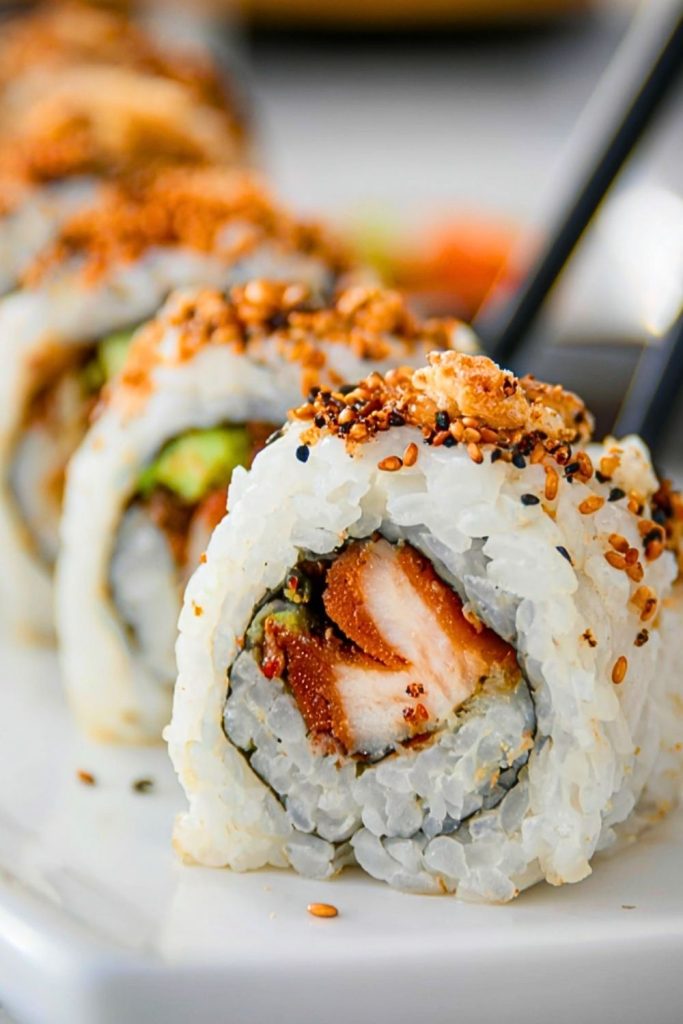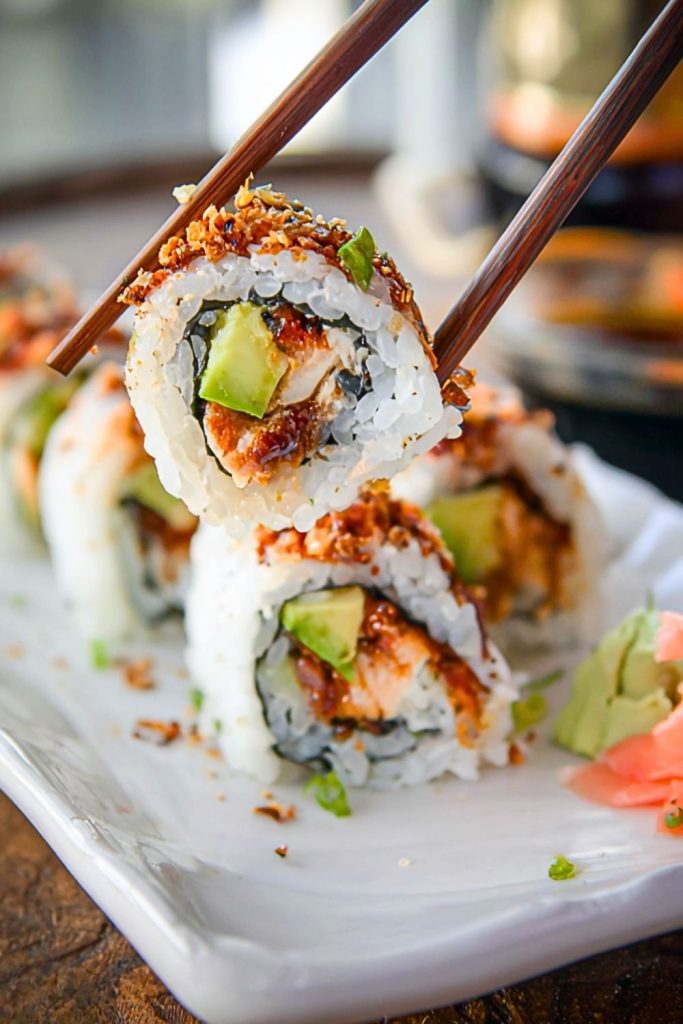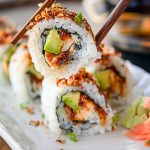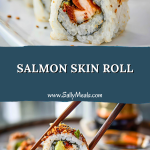I’ve always had a soft spot for sushi, but the Salmon Skin Roll holds a special place on my plate—and in my heart. It’s not just the smoky, crispy skin that makes this roll stand out, but the way it plays off the creamy avocado, the tangy bite of pickled vegetables, and that whisper of umami from the seasoned rice. It’s a bite that offers contrast and balance, and every time I make it at home, it transports me straight to my favorite sushi bar.

Making Salmon Skin Rolls at home might seem like a stretch, but once I gave it a try, I was surprised at how approachable and rewarding the process became. Whether you’re new to sushi-making or already comfortable rolling, this recipe gives you that restaurant-style result with the satisfaction of DIY flair. If you’ve ever tossed the skin from your salmon fillet—prepare for a revelation.
Why You’ll Love This Salmon Skin Roll
This isn’t just any sushi roll—it’s textural heaven. The crisped-up salmon skin adds a savory, almost bacon-like crunch that pairs beautifully with sticky rice and creamy elements like avocado or even a swipe of spicy mayo. It’s a roll that feels indulgent, but still fresh and clean. Bonus? It’s a great way to use every part of the fish, so nothing goes to waste.
What Kind of Seaweed Should I Use?
For a classic Salmon Skin Roll, you’ll want to use nori sheets—the dried seaweed that holds everything together. I always choose full-sized nori sheets and cut them in half for each roll. Look for ones labeled “sushi nori” at your local Asian market or online. They should be crisp and dark green-black in color. If the nori feels chewy or stale, it won’t hold the roll as neatly or give that subtle oceanic aroma that completes the experience.
Options for Substitutions
The beauty of the Salmon Skin Roll lies in its flexibility. While I adore the traditional combination, sometimes I like to mix things up depending on what I have in the fridge:
- Instead of salmon skin, try crispy smoked salmon or even grilled eel for a different flavor profile.
- No sushi rice? You can use short-grain rice tossed with a splash of rice vinegar, sugar, and salt for a quick substitute.
- Avocado swap? Use thin slices of cucumber or julienned mango for a refreshing twist.
- Vegan variation? Try crispy tofu skin or eggplant skin crisped in a pan—it won’t be the same, but the crunch and flavor will surprise you.
- Want extra kick? Add a smear of sriracha mayo or wasabi inside for some heat.
This roll is your canvas—start with the basics and feel free to color outside the lines.
Ingredients for this Salmon Skin Roll
Each component in this roll serves a purpose, both in flavor and texture. Here’s what you’ll need and why it matters:
- Salmon Skin – The star of the roll. When pan-fried or baked until crisp, it becomes irresistibly savory with a slightly smoky edge. It’s rich in oils, which adds depth to the roll.
- Sushi Rice – This sticky, vinegared rice is the base that holds everything together. Its slightly sweet and tangy flavor balances the fatty richness of the salmon skin.
- Nori Sheets – Thin sheets of dried seaweed that provide structure and a briny finish. They also add a pleasant chew and help keep the roll intact.
- Avocado – Creamy and cool, avocado adds a smooth texture that complements the crispness of the skin. It rounds out the flavors with a bit of softness.
- Cucumber or Pickled Daikon – These bring in crunch and a burst of freshness. Pickled options also add a little tang that cuts through the richness.
- Soy Sauce – For dipping. Its salty umami depth enhances every bite without overpowering the delicate ingredients.
- Toasted Sesame Seeds – Sprinkled on top for a nutty crunch and a hint of earthiness.
- Optional: Spicy Mayo or Wasabi – A little kick goes a long way. I often add a light drizzle inside or on top for heat and creaminess.
These ingredients work in harmony, creating a roll that’s crunchy, creamy, salty, and utterly satisfying.

Step 1: Prepare the Salmon Skin
Start by removing the skin from a fresh salmon fillet if it’s not already separated. Use a sharp knife to clean off any excess flesh attached to the skin. Then, pat it dry and season lightly with salt. Place it skin-side down in a hot pan (no oil needed if your pan is nonstick) or bake it at 400°F (200°C) until it’s golden and crispy—this usually takes 10–15 minutes. Once cooled, slice it into thin strips.
Step 2: Make the Sushi Rice
Rinse 1 cup of sushi rice several times until the water runs clear. Cook according to your rice cooker’s instructions or stovetop directions. While the rice is still warm, gently mix in a blend of 2 tablespoons rice vinegar, 1 tablespoon sugar, and ½ teaspoon salt. Let it cool to room temperature before using.
Step 3: Lay Out Your Rolling Mat
Place a bamboo sushi mat on a flat surface and cover it with plastic wrap (this keeps the rice from sticking). Place half a nori sheet, shiny side down, on the mat.
Step 4: Spread the Rice
With wet fingers, press a thin, even layer of sushi rice over the nori sheet, covering the entire surface. Flip the sheet over carefully so the rice is facing down and the nori is on top.
Step 5: Add the Fillings
Line the center of the nori side with your crisped salmon skin, a few slices of avocado, and cucumber or pickled daikon. If using spicy mayo or wasabi, add a thin line here as well.
Step 6: Roll It Up
Use your thumbs to lift the mat while holding the fillings in place with your fingers. Gently roll it away from you, pressing lightly to keep the shape tight and uniform. Once rolled, give it a final press to seal the shape.
Step 7: Slice and Garnish
Use a very sharp knife dipped in water to slice the roll into 6 to 8 even pieces. Sprinkle with toasted sesame seeds and, if you like, a bit of crispy topping or more spicy mayo.
How Long to Cook the Salmon Skin Roll
The actual roll doesn’t require cooking—just assembly. But the salmon skin is where the cook time comes in. You’ll want to bake or pan-fry the skin for 10 to 15 minutes until it’s golden and crisp. After that, allow it to cool slightly before rolling. As for the rice, plan for about 15 to 20 minutes total (cooking and seasoning), and allow it to cool to room temperature before use.
Altogether, the process from prep to plating can take around 40 minutes, especially if it’s your first time.
Tips for Perfect Salmon Skin Roll
- Crisp is Key: Make sure the salmon skin is completely dry before cooking. Moisture is the enemy of crispness.
- Use Plastic Wrap on Your Mat: This prevents rice from sticking and helps create smooth, tight rolls.
- Wet Your Hands: When handling sushi rice, wetting your fingers keeps it from sticking and lets you spread it more evenly.
- Sharp Knife Only: A dull knife will squash your roll. Use a sharp one, and clean the blade with a damp cloth between slices.
- Don’t Overstuff: It’s tempting to pile in ingredients, but less is more when it comes to rolling sushi cleanly.
- Cool the Rice Properly: Don’t roll with hot rice. Let it cool to room temperature or it will steam the nori and make it soggy.
These small details make a big difference in turning a homemade roll into a sushi-bar-worthy plate.
Watch Out for These Mistakes While Cooking
Even with simple ingredients, sushi-making can have its quirks. Keep an eye out for these common slip-ups:
- Not drying the salmon skin properly – It won’t crisp up if there’s moisture. Pat it thoroughly with paper towels before cooking.
- Overcooking the skin – You want it crisp, not burnt. Watch closely during the final minutes.
- Using too much rice – A thick rice layer overwhelms the roll and makes it harder to roll neatly.
- Skipping the vinegar seasoning in rice – That sweet-tangy balance is what gives sushi rice its identity.
- Cutting without a wet knife – Sushi rice sticks to dry blades and ruins clean slices.
- Rolling too loosely – If the roll isn’t tight, it’ll fall apart when slicing or eating.
Stay mindful of these and your Salmon Skin Roll will look and taste just right.
What to Serve With Salmon Skin Roll?
Miso Soup
A warm, umami-rich miso soup is the classic pairing, offering comfort and balance to the chilled roll.
Edamame
Lightly salted and steamed edamame makes for a simple, healthy side that complements sushi’s delicate flavors.
Seaweed Salad
That tangy-sweet, sesame-flavored seaweed salad adds contrast and brightness.
Pickled Ginger
Perfect for cleansing your palate between bites, enhancing the enjoyment of each piece.
Tempura Vegetables
Crispy, golden, and lightly battered veggies add a satisfying crunch that pairs well with the roll’s textures.
Cucumber Sunomono
A refreshing vinegar-dressed cucumber salad that cools and contrasts the savory richness of the salmon skin.
Green Tea
A hot cup of green tea helps digest and adds subtle bitterness to offset the roll’s richness.
Sake or Light Beer
If you’re looking for a drink, a cold sake or crisp lager matches beautifully with the flavors of this roll.
Storage Instructions
If you have leftovers (which isn’t likely!), it’s best to store Salmon Skin Rolls in an airtight container in the refrigerator. Wrap them tightly with plastic wrap first to prevent the rice from drying out. They’ll keep well for up to 24 hours, but note that the rice texture will firm up and the nori may soften.
To maintain the best texture:
- Don’t freeze the rolls—sushi rice and seaweed don’t thaw well.
- If possible, store the ingredients separately and roll fresh portions as needed.
Estimated Nutrition
These values are based on a standard Salmon Skin Roll (about 6–8 pieces):
- Calories: ~280–320 kcal
- Protein: ~10–12g
- Carbohydrates: ~30–35g
- Fat: ~12–15g (mostly from salmon skin and avocado)
- Fiber: ~3–4g
- Sodium: ~500–600mg (depends on soy sauce and seasoning)
These numbers can vary depending on portion size and added ingredients like sauces or pickled vegetables. It’s a relatively balanced dish that satisfies cravings without going overboard.
Frequently Asked Questions
What is the best way to get crispy salmon skin?
The key is to start with dry skin and cook it at high heat. Either pan-fry it skin-side down until crisp or bake it in the oven at 400°F for 10–15 minutes. Pressing it flat with a pan or weight helps it stay evenly crisp.
Can I use store-bought salmon skin?
Some Asian markets sell pre-cooked crispy salmon skin snacks. While they’re not a perfect substitute, they can work in a pinch for texture and flavor.
Is sushi-grade salmon skin necessary?
Not necessarily. Since the skin is cooked, it doesn’t need to be sushi-grade. Just make sure it’s fresh, well-cleaned, and from a trusted source.
Can I make this roll ahead of time?
You can prep the ingredients in advance, but it’s best to roll and slice right before serving to maintain the best texture—especially the crispiness of the skin and the freshness of the rice.
What’s a good vegetarian alternative for salmon skin?
Crispy tofu skin, roasted eggplant skin, or even seasoned mushroom strips can offer a similar savory bite without the fish.
How do I keep the roll from falling apart?
Keep your rice layer thin, don’t overfill with ingredients, and roll firmly using a bamboo mat. Wetting your knife before slicing also helps keep the shape intact.
Is it safe to eat salmon skin?
Yes, as long as it’s properly cooked and cleaned. It’s rich in omega-3s and adds a flavorful, crispy element to dishes.
What sauces go well with Salmon Skin Roll?
Soy sauce is the classic choice, but spicy mayo, eel sauce, or ponzu can elevate the flavors even more. A light drizzle inside the roll or on top adds a gourmet finish.
Conclusion
Making a Salmon Skin Roll at home might seem ambitious, but it’s honestly one of the most rewarding sushi experiences. With a handful of ingredients and some patience, you can craft a roll that’s crispy, creamy, tangy, and umami-packed all in one bite. Whether you’re using up leftover salmon skin or looking to impress your dinner guests, this roll brings sushi-bar flair straight to your table.

Salmon Skin Roll
- Prep Time: 25 minutes
- Cook Time: 15 minutes
- Total Time: 40 minutes
- Yield: 1 roll (6–8 pieces) 1x
Description
A Salmon Skin Roll is a sushi roll made with crispy pan-fried or baked salmon skin, creamy avocado, and crunchy vegetables, all wrapped in seasoned sushi rice and nori. It delivers rich texture, bold flavor, and a satisfying balance of umami, salt, and freshness.
Ingredients
- 1 sheet nori (dried seaweed)
- 1/2 cup cooked sushi rice
- 1 salmon skin (from a fillet, cleaned and dried)
- 1/4 avocado, sliced
- 2 to 3 cucumber sticks or pickled daikon
- 1 tsp rice vinegar (for rice seasoning)
- 1/2 tsp sugar
- Pinch of salt
- Toasted sesame seeds (for garnish)
- Soy sauce (for dipping)
- Optional: spicy mayo or wasabi
Instructions
- Preheat oven to 400°F (or use a hot nonstick pan).
- Clean and dry the salmon skin. Bake or pan-fry skin-side down for 10–15 minutes until crispy. Let cool and slice into strips.
- Rinse and cook sushi rice. Mix rice vinegar, sugar, and salt, and stir into warm rice. Let it cool to room temperature.
- Place half a sheet of nori on a bamboo mat covered with plastic wrap.
- With wet hands, spread an even layer of sushi rice on the nori, then flip the sheet so the rice is underneath.
- Layer the salmon skin, avocado, and cucumber or daikon across the center.
- Add optional spicy mayo or wasabi if desired.
- Roll tightly using the mat. Press gently to seal.
- Slice into 6–8 pieces with a sharp, wet knife.
- Garnish with sesame seeds and serve with soy sauce.

